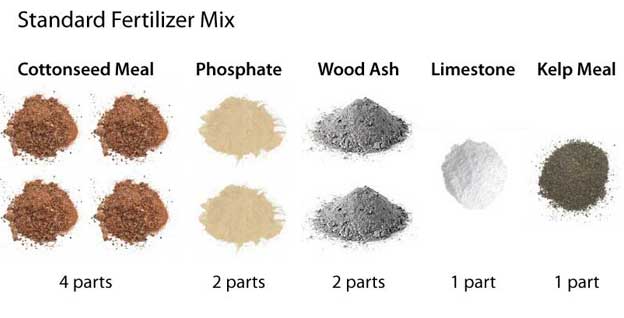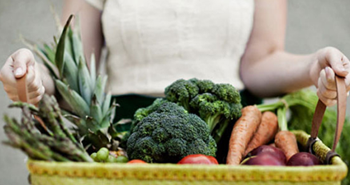
Making your own fertilizer mix has several advantages over buying a pre-packaged mix. That’s why it’s a basic component of Smart Gardener’s approach to organic gardening.
Here’s a couple reasons why we like it so much:
1) Simplicity. It makes the whole question of “Which fertilizer do I use?” much simpler. It reduces the amount of boxes, bags and bottles of lots of different fertilizers you have to buy and store.
2) Less costly. It can save you quite a bit of money (as much as 50%), which you can then use for other gardening purposes.
3) Easy. It doesn’t take much time or effort to mix the various materials together, though it can be a bit dusty and the bulk bags are fairly heavy (they usually weigh 50 lb).
4) More flexibility. You can alter the recipe to better suit individual crops and can avoid materials you don’t like (for ecological, ethical or other reasons).
5) Buying bulk and sharing. If you buy the ingredients in the large bags. it’s great for community or school gardens, as well as sharing with neighbors or friends.
Where to buy
Generally the cheapest place to buy your materials is from a farm supply or feed store (a rule of thumb says that it’s cheaper to use materials sold as animal feed rather than fertilizer). If you don’t have a local feed store or farm supply, then your next option is a garden center. These are set up for home gardeners so everything is in one place and it’s easy to compare materials and prices.
Choosing the ingredients
A complete fertilizer mix will include a source of each of the primary nutrients: nitrogen, phosphorus and potassium, as well as the secondary nutrients (calcium, magnesium and sulfur) and trace elements. The materials you choose depends not only on their nutrient content, but whether your priority is cost, organic purity (the cheaper amendments are mostly waste products from commercial agriculture and may contain pesticide residues or GMO’s) or ethical concerns (we won’t use products from industrial livestock raising).
How much to buy
Some ingredients are used in much greater quantities than others, so if you simply buy one sack of each material you will run out of one ingredient before any of the others. The next time you go to buy ingredients, you will only need to buy those that are in short supply.
Mixing
For convenience you can mix all of the ingredients at once and store it in a cool dry place (though it’s probably best not to store the mix for too long). You can also store them separately and mix as needed. We use the white 5 gallon plastic pails with lids.
The recipe uses proportional quantities so you can use any container (whether a gallon pail or a teaspoon) to make as much as you need. I usually put all of the separate ingredients into a wheelbarrow and mix them thoroughly with a shovel (wear a dust mask as some of the finer ingredients are pretty dusty). It’s not a bad idea to do this over a clean hard surface, so you can recover anything you spill. For smaller quantities, a gardening bucket or pail works well.
Storage
I store the prepared mix in a plastic bin, though you could also use the paper sack the amendments came in. Some of these amendments are edible, so if you have rodent problems you will have to store them in a secure metal or plastic container, otherwise they may get eaten (and you may have a rodent explosion). They also need to be kept dry of course, otherwise they will rot.

Standard Mix
This is a mix of various amendments intended to supply all of the nutrients plants may require. It is usually incorporated into the soil prior to planting. The mix consists of:
4 parts cottonseed meal (this is high in nitrogen and relatively inexpensive)
2 parts colloidal phosphate or bone meal (for phosphorus)
2 parts wood ash or 3 parts greensand or granite dust (for potassium)
1 part dolomitic limestone (to balance pH and add calcium and magnesium)
1 part kelp meal (for trace elements)
Mix these together thoroughly. You can do this all at once, or you can store them separately and mix as needed.
Optional extra
2 parts of sifted worm castings (This adds microorganisms and micronutrients). I prefer to store this separately and add shortly before using.
Custom mixes
You don’t have to use the recipe above, you can customize it to better suit the crop you are growing. Conventional wisdom recommends giving additional nitrogen to leaf crops, potassium to root crops and phosphorus to seed or fruit crops, so you could add extra of these as required.


